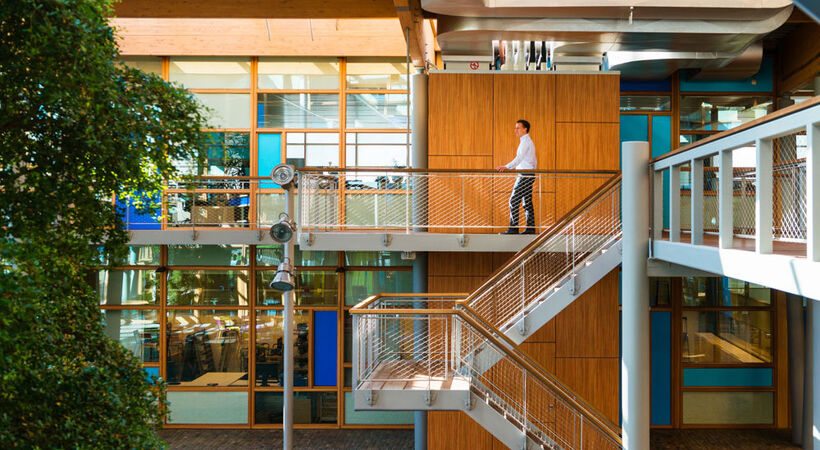With recent studies indicating that a sizeable percentage of employees believe their workplaces are having a negative impact on their health, the issue of wellness is coming into ever-sharper focus. It’s good to discover, then, that smart building controls can make a world of difference, says Priva UK and Ireland sales manager Gavin Holvey.
Debate around the issue of workplace wellness has been going on for a long time now, but in the last few years it has assumed a fresh intensity. In no small part this can be attributed to the now-substantial weight of academic research and independent studies, with the results of these reports often making for decidedly alarming reading.
The recent British Council for Offices (BCO) report, ‘Wellness matters: heath and wellbeing in offices and what to do about it’ (1), is a case in point. Less than half of respondents felt that their workplace was having a positive impact on their health, whilst 17% indicated that their working environment could actually be diminishing their personal wellbeing. And with the Health & Safety Executive reporting that 25.7 million UK working days were lost to work-related ill-heath during 2016 and 2017 alone (2), it is evident why so many public and private sector organisations are expressing concern.
Lost working days are bad enough, but inadequate workplaces also have a detrimental effect on productivity among those who do make it into the office or factory day after day. Over extended periods this can contribute to both collective and individual loss of morale, as well as conditions such as depression and anxiety. The implications of all this for staff retention should speak for themselves.
Fortunately, the outlook is far from being all doom and gloom. The BCO report is among the many studies to indicate that for those businesses who do seek to improve workplace wellness there are tremendous potential benefits in terms of output, results, and ability to attract and keep the most talented personnel. Also, there is now a wealth of guidance that can be accessed regarding the creation of a healthy environment at every stage of a building’s life cycle – from design and construction to occupation and management – as well as widely recognised standards that can be adopted, not least the International WELL Building Institute’s WELL Building Standard (3).
This comprehensive standard shines a light on many factors that contribute to the working environment, including the role that technologies such as integrated control systems can play in delivering a workplace that is consistently conducive to health and productivity. Here at Priva this is an awareness that has been informing the development of new ‘smart’ control systems for many years now.
Lighting, heating & comfort
Produced by UKGBC and issued by the World Green Building Council, a report entitled ‘Health, wellbeing and productivity in offices: the next chapter for green building’ (4) pinpoints good indoor air quality, thermal comfort, good lighting conditions and the minimisation of unwanted noise as being among the key elements of healthy and productive workplaces.
Without doubt the implementation of smart building controls makes it significantly easier to satisfy these requirements. With one integrated building management system (Priva’s own Blue ID being a notable example) it is possible to control, regulate and optimise the technical installations of a building. Often built around user-friendly graphical interfaces that can be adapted and optimised to the customer’s specific requirements, the latest generation of systems make it far easier to maintain a dialogue with personnel about working conditions, and swiftly respond to any concerns of requests.
Of course, the ability to monitor and easily adjust building systems also has positive implications for financial outlay, particularly where individual systems – for example, lighting – are linked to occupancy sensors that can dramatically reduce unnecessary energy usage. In many cases the implementation of such systems can have RoI periods of only a few years as double-digit percentage reductions in energy consumption are by no means uncommon.
With Priva among those suppliers to be offering highly scalable systems to suit all manner of budgets and facility types – as well as the support and advice necessary to make the most of them – smart building controls are increasingly looking like a no-brainer. As the UKGBC-authored report observes, “putting trust in the occupier and putting them at the centre of design, including personal control over their indoor environment, can reap rewards in terms of satisfaction, productivity and energy performance.”
The fact that workers are going to be obliged to work for considerably longer in the future – indeed, the World Economic Forum recently suggested that the retirement age in Britain and other leading developed countries will need to rise to 70 by 2050 because of the growing pensions crisis – means that the need to maintain a healthy workforce is only set to become more acute in the future. With their ability to offer unprecedented control over the working environment, smart building systems are destined to provide a major piece of the wellness puzzle.
Sources:
(1) Wellness Matters: Health and Wellbeing in Offices and What to Do About It: http://www.bco.org.uk/News/News34396.aspx.
(2) Health & Safety Executive: http://www.hse.gov.uk/statistics/dayslost.htm
(3) WELL Building Standard (V2): https://v2.wellcertified.com
(4) UKGBC: https://www.ukgbc.org/ukgbc-work/health-wellbeing-productivity-offices-next-chapter-green-building/
(5) World Economic Forum: https://www.weforum.org/press/2017/05/global-pension-timebomb-funding-gap-set-to-dwarf-world-gdp/




